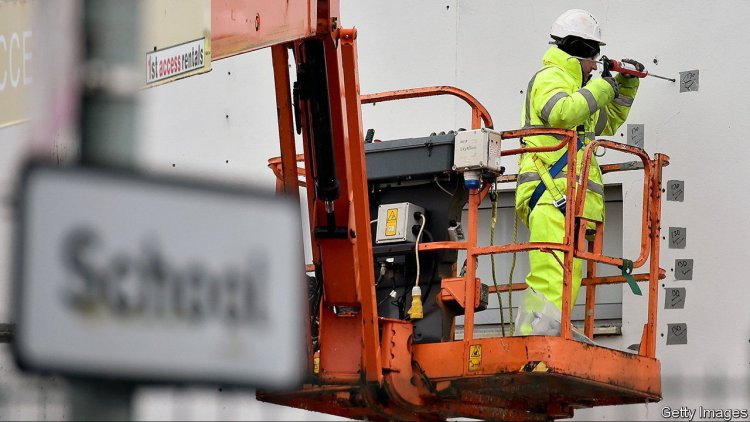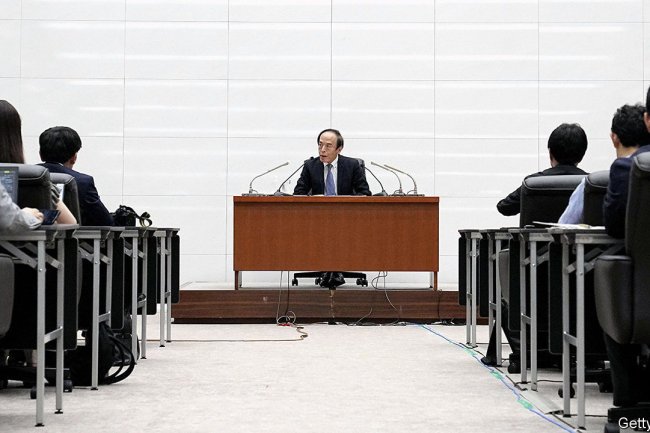Britain’s rotten buildings reflect its dismal public services
image: Getty ImagesTHE QUEEN ELIZABETH HOSPITAL in King’s Lynn, Norfolk, is a sprawling maze of two-storey concrete blocks. Opened in 1980, it once counted royals among its patients. They have stopped coming, perhaps because water leaks through the ceiling. Deemed at risk of collapse five years ago, the roof is propped up by 3,500 wooden, steel and plastic stilts. A dozen inspectors conduct round-the-clock checks for problems. The decay at that hospital is part of a broader decline in many of Britain’s hospitals, schools, courts and prisons. Last year the hospital-maintenance backlog, which the NHS tracks, passed £10bn—almost double the figure from 2016. More than £2bn of that is “high risk”. The condition of schools is worsening, with 700,000 pupils taught in shoddy classrooms. Many prisons are “squalid, poor, overcrowded, insanitary and unacceptable”, says the prisons inspector. Mould and damp force the closure of much-needed cells. The worsening neglect brings a risk of tragedy. In


THE QUEEN ELIZABETH HOSPITAL in King’s Lynn, Norfolk, is a sprawling maze of two-storey concrete blocks. Opened in 1980, it once counted royals among its patients. They have stopped coming, perhaps because water leaks through the ceiling. Deemed at risk of collapse five years ago, the roof is propped up by 3,500 wooden, steel and plastic stilts. A dozen inspectors conduct round-the-clock checks for problems.
The decay at that hospital is part of a broader decline in many of Britain’s hospitals, schools, courts and prisons. Last year the hospital-maintenance backlog, which the NHS tracks, passed £10bn—almost double the figure from 2016. More than £2bn of that is “high risk”. The condition of schools is worsening, with 700,000 pupils taught in shoddy classrooms. Many prisons are “squalid, poor, overcrowded, insanitary and unacceptable”, says the prisons inspector. Mould and damp force the closure of much-needed cells.
The worsening neglect brings a risk of tragedy. In 2018 the roof of a primary school in Kent collapsed – fortunately, on a Saturday when the building was empty. How many other schools are at risk? Troublingly, no one is sure. The National Audit Office, a watchdog, says that the education department does not have a good estimate “The only reason we haven’t had a fatality is luck,” says Matthew Byatt, president of the Institution of Structural Engineers, a professional body. “The propped-up ones aren’t the ones to worry about.”
Rotten buildings do harm even if they don’t fall down, because they sap productivity. Last year, 373 days were lost in court in England and Wales because courtrooms and equipment were not usable. The Law Society, a trade body, estimates that two-thirds of lawyers have experienced delays, for example because broken boilers have cut off heating.
The problem looks especially bad in hospitals. Health wonks have struggled to understand why NHS productivity has stalled despite big increases in spending on staff. (The NHS’s waiting list for elective procedures, now more than 7.2m long, has never been worse. Public satisfaction is at a record low.) Broken buildings and equipment are a big part of the answer, argue Rachel Wolf and Sam Freedman, former policy advisers. This year mould caused part of the ceiling at a hospital in Manchester to collapse, delaying hundreds of appointments for patients with cancer. Doctors are also slowed down by poor IT systems and a lack of testing equipment. Such conditions affect the morale of staff. Two operating theatres at the Queen Elizabeth are closed because of safety concerns. As a result, medical staff must shuffle around to accommodate repairs. “Dancing around buckets and scaffolding poles makes life pretty difficult,” says Alex Stewart of Healthwatch Norfolk, a charity.

Why is Britain’s public-sector estate so run down? The first, most obvious reason, is a lack of money. Britain has long had lower public-sector capital investment than other countries. Even in the 2000s, when the economy was in good shape, capital spending on health care (as a share of GDP) was usually well below the average for the OECD, a club of mostly rich countries. After 2010 capital spending plunged (see chart). Forced to make deep cuts, departments reduced investment sharply to protect day-to-day spending. As Tom Pope of the Institute for Government, a think-tank, points out, that was “politically easier”. It is more painful to cut spending on staff than investment in buildings and equipment, because the consequences of the underinvestment take longer to show up. The rot sets in slowly, but once it does, it is hard to reverse.
A second problem is that spending on buildings has been lumpy. Since the 1980s, capital spending has been six times more volatile than day-to-day spending, says the Resolution Foundation, a think-tank. Famine is followed with the promise of a feast, which is then withdrawn. This story has played out once again since 2016, as ministries raided budgets allocated for investment. Thus planning is hard. Supply-chains are not made ready, so departments struggle to spend well. Projects are likelier to be delayed and to go over budget. An election promise in 2019 by Boris Johnson, a former prime minister, to build 40 new hospitals by 2030 is one such example. Only three of the intended projects were in fact new hospitals. Just one has been completed, whereas 33 have not yet even had business cases approved. Money for them has not materialised. A promise to provide 20,000 new prison places has suffered a similar fate.
Mismanagement is a third problem. Politicians in general, not only Mr Johnson, much prefer to promise voters shiny new projects than to spend on essential maintenance for existing stock (which often has to be paid out of capital budgets). In addition, buildings are then used well beyond their recommended lifetime. That, in the long run, often costs more than replacing a building on time. The Queen Elizabeth is a prime example. It should have closed in 2010 but has staggered on. In 2021 it was given £21m to stave off problems a little longer—a “complete false economy”, as Mr Stewart puts it. Leaky portacabins have long been a feature of the school estate. Failure to maintain, or retire, assets is less common in the private sector because of the higher overall costs.
Fourth, many public buildings were badly built in the first place. Between the 1950s and 1980s builders of schools and hospitals often used “reinforced autoclaved aerated concrete”. Lightweight and cheap, it was especially popular for flat roofs. Unfortunately, it also proved to be porous. Over time steel rods incorporated into the roofs rust and expand, working away from the concrete. Roofs absorb water, sag, and eventually collapse. That is what happened at the school in Kent and could happen at the Queen Elizabeth. Mr Byatt likens the potential impact of aerated concrete to asbestos, an insulation material that became especially popular post-war and turned out to be hazardous, and costly to replace. Dealing with the concrete will dominate capital investment in health and education in years to come.
The Queen Elizabeth is, in fact, relatively lucky. It is one of five hospitals (all built with aerated concrete) that the government has promised to replace by 2030. The outlook for the rest of the public-sector estate is less rosy. At the last budget Jeremy Hunt, the chancellor, froze capital spending beyond 2025. Sir Keir Starmer, the Labour leader, has no plans to increase it - aside from a green investment programme. Sir Keir wants to “build an NHS fit for the future”, but his proposals focus on staff and barely mention buildings. He promises only to review projects to eliminate waste and ensure efficiency.
In the past, efforts to improve the public estate happened only when the economy and public finances were in good shape. Hospital-building boomed in the 1960s. In the 2000s New Labour invested billions in schools and hospitals (it also used private-finance initiatives, a method since generally disavowed as poor value for money). Today Britain faces sluggish growth, high debt and high interest rates. This suggests that financing for the next round of improvements will be hard to find. But without it, Britain should not expect to get better public services. ■
For more expert analysis of the biggest stories in Britain, sign up to Blighty, our weekly subscriber-only newsletter.
What's Your Reaction?






















